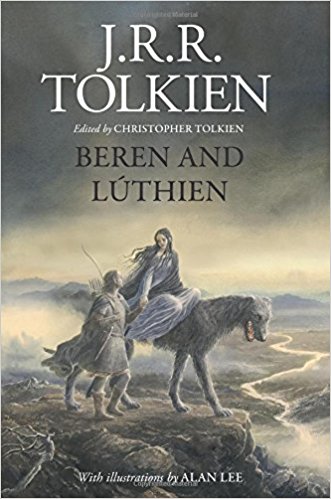Beren and Luthien by J.R.R. Tolkien
J.R.R. Tolkien’s “Beren and Luthien”, published for the first time as a standalone novel by his son, Christopher Tolkien, last year (2017), is a romantic fairy-tale and fantasy story about the love and journey between a mortal man – Beren - and an Elfin maiden – Luthien. The tale is included in Christopher Tolkien’s edition of his father’s other work, “The Silmarillion”, but is, in this publication, told in full detail, with most of J.R.R. Tolkien’s editions, revisions, embellishments and subtractions included. Reading this publication is like listening to the same piece of music over and over again. Though it is the same song being played, each time it is played the song sounds quite different, with each unique articulation changing the mood, tone, and pace of its story, allowing the listener, or here, the reader, to pay attention to the intricate details, from which an infinite amount of meanings and renderings can be produced.
“Beren and Luthien” was notably written a year after J.R.R. Tolkien returned home to Britain from the war – the Battle Of Somme – in France, 1916. The first version of “Beren and Luthien” in this book is written as a story (most of the others are long epic poems). It is called “The Tale Of Tinuviel” - Tinuviel is another name for Luthien; those familiar with Tolkien know that many of his characters go by multiple names. Tolkien describes Tinuviel as the most beautiful Elfin maiden that lived, with long shadowy dark hair and fair skin. But almost more enchanting than her outward beauty was her magical dancing. She was of the woodland fairies and she did not fear any part of the natural landscape, moths and ferns and etc. And she danced in this landscape freely, though no one from another race saw her.
Her brother, Dairon, made music with the reeds and woods of the forest, and it was to this music, full of the power of the elves and fairies, that she danced. They were far away in another land in the woods, but still, Beren, the mortal son of a mortal forester and group of hunters, saw her. He fell in love with her immediately, and soon they met, and she too fell in love with him. Once Tinuviel’s father the King saw Beren within his halls he questioned him, asking who dared enter into his palace. And when he found out about the true love between his daughter and this mortal man, he mocked him and dared him to steal a Silmaril (one of the most dazzling and potent jewels in the universe) from the most terrifying and evil monster in the world: Melko. And Beren took his dare in order to live happily with his maiden and the maiden herself dared to beg her family to go with him on his journey. But this did not happen. Beren went alone and became a prisoner of Telvido, Prince of Cats, minions of the evil Melko, and Tinuviel was trapped behind a forest of beech trees, due to her father’s controlling care for her.
Tinuviel then devised a plan using her magic and after some time had woven a cloak with the power to cast anyone in its vicinity asleep. And she escaped and found Beren with the help of a kindly but fierce dog named Huan. And she and Beren were able to free themselves from the land of Melko, but not with much anguish and suffering first. Tolkien’s adventure scenes are fast and breathtaking, and the tale ends bittersweet and finally triumphant.
The fairy-tale romance is thus with Tinuviel/Luthien, her bravery made even stronger with her heart full of love. And Beren, whose naivety becomes courage and hope with his own heart full of love. Furthermore, the fairy-tale romance is strengthened by their two differing origins which collide in a world of otherworldly magic touched by human strength, with both places full of awe-striking histories and manifestations. The fantasy/adventure begins and ends with journeying; the journeying of Beren until he finds Tinuviel for the first time, and then Tinuviel’s journey to Beren once he is separated from her. Finally, their journey back home, the first to the home of Tinuviel’s, and the second a mysterious place where they abide together, after almost forever losing each other on more than a couple occasions.
The book’s contents include a Glossary and List Of Names at the end. Christopher Tolkien’s Preface is enough to introduce a new Tolkien reader into the world and mythology of Middle Earth. An added treasure within the pages include illustrations by Alan Lee, here presented as book plates, which can’t be said to be less than anything but fantastic.




Comments
Post a Comment